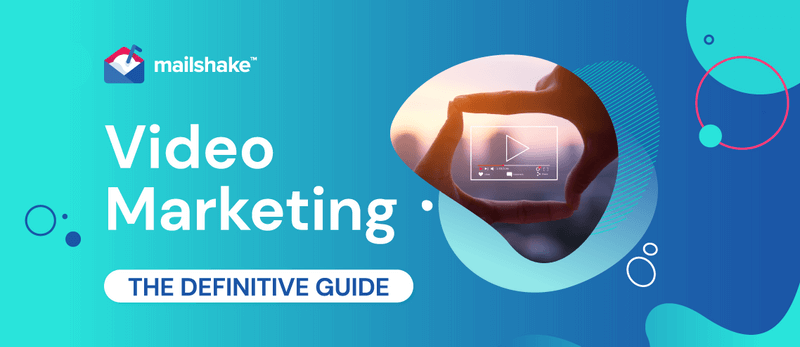Video Marketing: The Definitive Guide for 2025

Contents
The internet is oversaturated with content. Everywhere you look, there’s another brand trying to vye for your attention.
Out of all the mediums available to marketers, video has a distinct advantage: its use of motion immediately catches your eye (and if your sound is on, your ears) in a way that other mediums can’t.
In this guide, we’re going to teach you how to leverage video marketing to your advantage.
What Is Video Marketing?
In short, video marketing means using video to grow brand awareness, engage your target audience, and, ideally, persuade them to purchase your products or services.
It’s important to distinguish video from television marketing. Although TV ads use video, when people refer to video marketing, they are generally talking about the use of video in a digital and/or social media context.
Essentially, video marketing is a branch of digital marketing that touches on both social media and content marketing.
Although video marketing is prevalent, it’s often overlooked by many brands, largely because it tends to be more difficult to produce a professional video than to make a blog post. However, it’s not a good idea to write it off just because of its difficulty, as video can be particularly effective.
Why Use Video Marketing?
Humans are evolutionarily programmed to pay attention to motion — any small movement could be a danger lurking, waiting to spring on you. Large walls of text that don’t move… much less likely to pose a threat.
As a result, video grabs people’s attention unlike any other medium. That means that videos are likely to stand out among the boatload of content that’s competing for your audience’s interest.
Beyond piquing your audience’s interest in the first place, it can also sustain it. In fact, adults are 73% more likely to make a purchase after watching a product video.
All together, this is likely why video marketing is considered by marketers to be the number one content type for sales.
How to Build a Video Marketing Strategy
If you’re ready to dive into video, here’s what you’ll need to do.
1. Start With Your Goals
It’s impossible to achieve a goal if you don’t have one set in the first place. Before you move onto anything video-specific, ensure that you know what you hope to achieve with your video marketing project.
Typically, your video will want to target one of three different stages in the buyer’s journey:
- Awareness: At this stage, your video serves to introduce people to your brand by pointing out what problems your products or services solve.
- Consideration: Once your viewer gets to this point, they clearly understand what their problem is and are looking at several potential solutions. The goal of your video is to show them how your product can help and, to some extent, why it’s better than the competition.
- Decision: Here, you take things to the next level. Your customer is just about ready to make a purchase, so your content needs to prove to them that you have satisfied customers. Your video may also directly compare your product to competitors to show how it’s a stronger solution.
2. Find Your Target Audience
Marketing videos are always made with a target audience in mind — they’re made to sell products, not to create a unique and genre-defying artistic expression.
While artists can create freely and without considering their audience, that freedom being the key ingredient to groundbreaking new works, marketers always need to keep their audience at the forefront of their minds. That’s not to say that marketing videos can’t be creative and artistic — the best often are — but rather just that the process is different, and the end goal isn’t creativity in itself.
If you’re an established business, then chances are you already know who your audience is. If you’re just starting out, it’s a good idea to construct a buyer persona to better understand who it is you’re trying to reach.
3. Figure Out What Story You Want to Tell
Stories are an essential part of everyone’s development — they guide our lives and inform the decisions we make. From practically the moment we are born, we seek out and share stories.
Video, of course, is a powerful storytelling medium. If you want to use it to its fullest power, you need to be clear on what story you want to tell.
Sometimes, there won’t be a particularly clear cut story. But there is usually one hiding below the surface. Even in a product video, you can tell the story of the resolution of the pain point. In a testimonial video, you can tell the story of how the customer’s life improved.
Whatever you are featuring in your video, look for a way to make it more of a story, and you’ll be more likely to connect with people in a more meaningful way.
4. Stay On Top of Your Creative Requirements
Video production involves a lot of moving parts. There’s the scriptwriting, casting, set design, editing, lighting — and that barely scratches the surface.
It’s important to ensure that all of these processes are being balanced and that there is enough time to receive feedback and implement changes, if necessary. For example, if a change needs to be made to the script, you’ll want to be sure you haven’t started filming yet. To that end, make sure that you give enough breathing room between each step in the process and check in on everything periodically, especially if additional stakeholders are involved.
5. Keep to Your Timeline
Part of keeping all the moving pieces together in a video production comes down to making sure you have a solid timeline that you’re adhering to.
In reality, there will likely be multiple timelines for each individual component of the video production. However, it’s vital that they all move in synchronicity without one piece stalling the others.
As much as possible, try to keep to your timeline so that you can stay on track and produce your video efficiently. Your timeline will serve as your general guide throughout the process, and it will give you a convenient and easy way to track your progress.
6. Stick to a Realistic Budget
The reality of video marketing is that it tends to be expensive. So, while you might like the idea of a jaw-dropping campaign featuring alien CGI robots transforming into crime-fighting versions of your flagship beverage product, it’s important to be self-aware enough to realize that your brand likely doesn’t have a Hollywood budget for your marketing videos.
As difficult as it can be to limit yourself creatively, it’s a necessary part of making marketing videos. That said, limits can often breed creativity, so try to use your budget restrictions as inspiration and motivation instead of letting them stifle you.
The 8 Types of Marketing Videos
Overall, there are nine common types of marketing videos. Here are the ones you should be aware of.
1. Demo Videos
Demo videos, aka demonstration videos, are a way to show your audience exactly how your product works.
These videos are generally a bit easier to make than other types since they don’t require as much production equipment. If you’re a software company, for example, all you need is a script, a microphone, and a screen recorder.
2. Brand Videos
Brand videos are less specific than demo videos — they aim to show off your company as a whole. That includes what it does, what its vision is, and who’s behind the scenes.
These videos have more of an opportunity for storytelling, so make sure to do your best to tell your brand’s story in an engaging way.
3. Event Videos
If your brand hosts an event of some type, such as a conference or seminar, you can make an event video. This could either be a recording of the video stream for whole event or it could be a highlight reel, in which you select and edit together the standout parts.
4. Expert Interview Videos
Knowledge is valuable. If you can provide value to your audience before they ever make a purchase, you’ll instill a significant amount of trust in them, which will make them more likely to make a future purchase.
Expert interview videos provide that knowledge and value. By interviewing experts in your field, or perhaps even just experts in your company, you can provide something useful and make a real connection with your target audience.
5. Explainer Videos
Have you ever seen a video where there’s a marker drawing on a whiteboard and a narration over it that explains how a product works? If so, you know what an explainer video is.
Although all explainer videos don’t follow that same exact whiteboard format, they do all have the same end goal: explaining how a product works in the clearest and most engaging way possible.
These are different from demo videos that explain specific features, however. Explainer videos tend to focus on more general concepts. So, while a demo video for an email software might tell you how to set up an automated campaign, an explainer video would more typically explain what automated campaigns are and how a specific product can use them to make sales.
Incorporating a realistic avatar creator into explainer videos can add a personal touch, allowing viewers to connect with a lifelike character that guides them through the content.
6. Animated Videos
Animated videos often have a lot of overlap with explainer videos. In fact, animated videos are one of the most popular formats for explainer videos.
However, animated videos can really cover anything — they could be brand videos, explainer videos, or even animated expert interviews.
The bottom line is that animation is fun and engaging, so if it fits your company’s image, this is a great option to consider.
7. Case Study and Customer Testimonial Videos
These videos are generally used for the decision stage of the buyer’s journey. Here, you’ll tell the story of how your product or service helped a specific customer achieve their goals. Think of it like a video review — just one that is planned out in advance.
8. Educational and How-To Videos
Earlier, we mentioned how production value through knowledge is a powerful sales tool. Educational and how-to videos provide value to your customers by teaching them new skills or educating them on new topics.
Best Examples of Marketing Videos
The best way to learn is by example. Here are some of the best marketing videos around.
1. This Unicorn Changed the Way I Poop – #SquattyPotty
This classic video has withstood the test of time. With close to 40 million views on YouTube, it’s clear that this company did something right.
But what specifically? They combined humor with informative material to create a video that educates while it entertains — so called “edutainment.”
2. How to Use a Raw Egg to Determine if Your Mattress is Awful – Purple Mattress #goldilocks
This video is another marketing classic. For this one, Purple harkened back to the old days of marketing, when unique demonstrations reigned king.
Here, the company demonstrates how contouring its mattress is by staging a memorable test. The result is convincing and, quite frankly, pretty amazing, all of which makes for an unforgettable video.
3. Google — Year in Search
Every year, Google produces a video that shows what the world was searching for over the last twelve months. The videos are always well produced and carry an emotional weight that sticks with the viewer long after the video is over.
How to Measure the Effectiveness of a Video Marketing Campaign
Once your video marketing campaign is out in the world, you’ll need to measure its success. To do so, you should keep these metrics in mind:
- Click-Through Rate (CTR): The CTR can be calculated by dividing the number of times your call-to-action (CTA) was clicked by the number of times it was viewed.
- Play Rate: To find this metric, divide the times that your video was played by the total number of views.
- Shares, Likes, Comments, and Reactions: These all measure engagement and can be a good indicator of how well-received your video is.
- Watch Time: This refers to the total amount of time that your video was watched. You can calculate it by taking the total number of views and multiplying it by the average time watched.
- Return On Investment (ROI): You can calculate your ROI by taking the dollar amount of sales your video generated and dividing it by the amount you spent to make your video.
Key Takeaways
Video marketing is an indispensable marketing medium in today’s digital economy. Not only does it catch a viewer’s attention unlike anything else, but it sustains it too.
Although producing a video can be more intensive than other content marketing efforts, it should not be overlooked.





